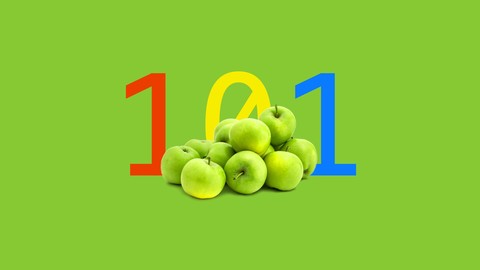
Programming 101
Programming 101, available at Free, has an average rating of 4.62, with 35 lectures, based on 17752 reviews, and has 166830 subscribers.
You will learn about Count bits Understand binary data Understand bit processing Understand basic network structure Understand routers, ISP's, packets and HTTP Full working knowledge of programming languages Understand the concepts behind a programming language Understand variables and constants Understand functions, arguments and parameters Know about software licensing Comprehend DRM, patents and morality of the industry This course is ideal for individuals who are Anybody from beginner or a seasoned professional who really wants to know the lower level stuff It is particularly useful for Anybody from beginner or a seasoned professional who really wants to know the lower level stuff.
Enroll now: Programming 101
Summary
Title: Programming 101
Price: Free
Average Rating: 4.62
Number of Lectures: 35
Number of Published Lectures: 35
Number of Curriculum Items: 35
Number of Published Curriculum Objects: 35
Original Price: Free
Quality Status: approved
Status: Live
What You Will Learn
- Count bits
- Understand binary data
- Understand bit processing
- Understand basic network structure
- Understand routers, ISP's, packets and HTTP
- Full working knowledge of programming languages
- Understand the concepts behind a programming language
- Understand variables and constants
- Understand functions, arguments and parameters
- Know about software licensing
- Comprehend DRM, patents and morality of the industry
Who Should Attend
- Anybody from beginner or a seasoned professional who really wants to know the lower level stuff
Target Audiences
- Anybody from beginner or a seasoned professional who really wants to know the lower level stuff
Most people do not know how their device’s process binary and work with data, from their washing machine to their smart phone. I found even some programmers don’t have the knowledge of such; I’m in fact guilty of this sin!
I missed out by learning a programming language first rather than trying to understand the computer on the hardware level. As programmers we are controlling the hardware and eventually even if you’re programming in Javascript you need to know about memory and how the language works. So understanding binary data, persistent and temporary memory, CPU, SPU, GPU, networking and more is crucial even if you’re a web developer this still applies to you.
This course will be a broad foundation of knowledge giving understanding of certain topics that need to be covered; giving you a solid foundation to grow from. I don’t believe in understanding a programming language first is the correct way to go about things. Programming languages have evolved as a tool for us. NOT the computer! So if we understand the computer’s hardware we’ll understand clearly how our program’s are controlling our device’s.
Computers are tools that we created to benefit man kind, however as all tools we need to improve them more and more. However the core principle of computers from the very first computer ever invented hasn’t changed. Over time the tool or computer has been refined. However the very core process and simplicity in underlying principles has been the same from the foundation of computing which is, processing ones and noughts. Computers have gone from processing 8 to 64 bits at any one time. This is just the computer being able to process more bits and thus more powerful operations can be done at a single time.
Don’t get me wrong computers are far more advanced, but the concept is all I’m saying is simple enough that even a beginner can learn what most people consider advanced and above their pay grade.
Likewise understanding networking is of vital importance especially for the web developers of today. More apps are going online so understanding network infrastructure, that has been around for over a decade, is still important today.
What about programming languages? We invented them as tools to communicate with these raw processing machines. We must understand why we have programming languages and how they work. For example what’re compilers or transpilers? How have we taken our form of communication, human�languages, and turned it into an effective communication to manipulate the computer, programming languages?What about variables, constants, functions, objects and arrays that are in all major programming languages today?�Also all languages have operators and if you didn’t have them in a programming language you wouldn’t actually have a programming language at all.
In this course we’ll cover even more, what about programming paradigms. Paradigm just means a model on how to do something. So in this case we can write our program’s in a certain way or in a certain paradigm. Very few beginners consider the style with which they program. When creating small scale apps it isn’t that difficult, however when creating large scale apps, paradigms become imperative.
Most programming languages give you the flexibility to mix and match programming paradigms or styles for writing your app’s. You have a few major styles to choose from such as assembly, procedural and object oriented. Do note in a single app you can mix these paradigms usually procedural and object oriented to best suite that part of your large scale app. I’ll show you the styles of these paradigms and then apply procedural and OOP (object oriented paradigm/programming) to demonstrate how the human mind works with differing paradigms; proving that multiple paradigms are the way forward.
Finally at the end of learning such a broad range of topics in a clear and concise course; you’ll also be learning about the licensing which should be covered especially for new comers. Then learning about software morality such as DRM, software patents and many other aspects of how the government is dealing with your data.
After all this, if you’re still not satisfied you can have your 100% money back guarantee if the course actually cost anything. So this last bit is really the bit that sells it, what have you got to loose?
Course Curriculum
Chapter 1: Introduction
Lecture 1: Introduction
Chapter 2: Understanding Hardware
Lecture 1: What is base 2?
Lecture 2: Understanding bits and bytes
Lecture 3: Counting binary
Lecture 4: Signed magnitude, signed or unsigned byte
Lecture 5: How do computers process binary data
Lecture 6: Evolution of 8 16 32 and 64bit computing
Lecture 7: Sound and recording
Lecture 8: Firmware and BIOS
Lecture 9: Temporary and persistent memory
Chapter 3: Basics of networking
Lecture 1: Basic network structure
Lecture 2: IPV4, IPV6 and packets
Lecture 3: MAC Addresses
Lecture 4: Servers and HTTP
Chapter 4: Understanding Operating Systems
Lecture 1: What is an operating system?
Lecture 2: API and the console
Chapter 5: Basic Programming Knowledge
Lecture 1: Programming languages & execution
Lecture 2: Interpreters, compilers & JIT compilation
Lecture 3: Programming, scripting & markup languages
Lecture 4: Client vs server side languages
Lecture 5: Higher & lower level programming languages
Lecture 6: Primitive data, nouns, adjectives & verbs
Lecture 7: Variables and constants
Lecture 8: Functions, parameters & arguments
Lecture 9: Objects & arrays
Lecture 10: Object hierarchy
Lecture 11: Operators
Chapter 6: Programming Paradigms
Lecture 1: Programming paradigms
Lecture 2: Programmable paradigm mindset
Lecture 3: The difference between OOP and object construction
Chapter 7: Conclusion and Goodbye
Lecture 1: Software morality – licensing
Lecture 2: Software morality – DRM and patents
Lecture 3: Software morality – data
Lecture 4: Where to start?
Lecture 5: Conclusion & Goodbye
Instructors
-
Lawrence Turton
Technical Instructor
Rating Distribution
- 1 stars: 97 votes
- 2 stars: 168 votes
- 3 stars: 1495 votes
- 4 stars: 6168 votes
- 5 stars: 9824 votes
Frequently Asked Questions
How long do I have access to the course materials?
You can view and review the lecture materials indefinitely, like an on-demand channel.
Can I take my courses with me wherever I go?
Definitely! If you have an internet connection, courses on Udemy are available on any device at any time. If you don’t have an internet connection, some instructors also let their students download course lectures. That’s up to the instructor though, so make sure you get on their good side!
You may also like
- Best Investing Courses to Learn in March 2025
- Best Personal Finance Courses to Learn in March 2025
- Best Health And Wellness Courses to Learn in March 2025
- Best Chatgpt And Ai Tools Courses to Learn in March 2025
- Best Virtual Reality Courses to Learn in March 2025
- Best Augmented Reality Courses to Learn in March 2025
- Best Blockchain Development Courses to Learn in March 2025
- Best Unity Game Development Courses to Learn in March 2025
- Best Artificial Intelligence Courses to Learn in March 2025
- Best Flutter Development Courses to Learn in March 2025
- Best Docker Kubernetes Courses to Learn in March 2025
- Best Business Analytics Courses to Learn in March 2025
- Best Excel Vba Courses to Learn in March 2025
- Best Devops Courses to Learn in March 2025
- Best Angular Courses to Learn in March 2025
- Best Node Js Development Courses to Learn in March 2025
- Best React Js Courses to Learn in March 2025
- Best Cyber Security Courses to Learn in March 2025
- Best Machine Learning Courses to Learn in March 2025
- Best Ethical Hacking Courses to Learn in March 2025






















